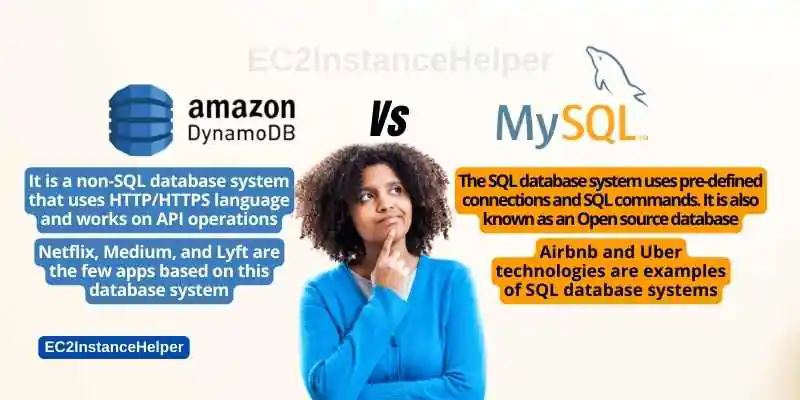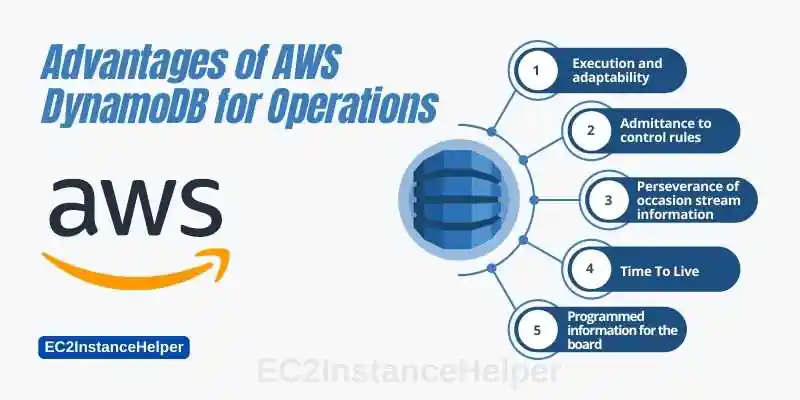In this comprehensive guide, we invite you to explore the inner workings of DynamoDB, Amazon Web Services’ fully managed NoSQL database solution. Designed to handle massive amounts of data and deliver lightning-fast performance, DynamoDB has revolutionized the way applications store and retrieve information in the cloud. Join us as we unravel the intricacies of this powerful database service, from understanding its flexible data model and schema-less architecture to exploring advanced features like auto-scaling, global tables, and on-demand capacity. Whether you’re a developer, an architect, or a database enthusiast, this guide will give you insights into the knowledge and expertise needed to harness the full potential of DynamoDB.
AWS Dynamo – Background Words
Storage and maintaining the data for a long duration with scalability is one the main issue faced by companies today. Electronic applications face scaling issues because of the development of clients alongside the expanding intricacy of information traffic. The cutting-edge intricacy of business comes with the need to deal with information quicker and all the more vigorously.
The standard conditional information bases aren’t the most ideal fit all the time. DynamoDB resolves scalability issues by offering replication of multiple data centers in a synchronized way. DynamoDB is a NoSQL programme.
All things being equal, data sets, for example, DynamoDB have been intended to deal with the new flood of information. DynamoDB is an Amazon Web Services data set framework that upholds information constructions and key-esteemed cloud administrations. It permits clients the advantage of auto-scaling, in-memory reserving, reinforcement, and reestablishing choices for all their web-scale applications utilizing AWS Dynamodb.
In any case, how would you need to utilize DynamoDB and what are a few instances of utilization cases?
How DynamoDB Works- 5 Important Applications
One reason individuals don’t utilize AWS Dynamodb is on the grounds that they are unsure whether it is ideal for their venture. A few models where organizations are utilizing DynamoDB to assist with dealing with the bigger deluge and of information at high paces are:
- Duolingo
- Major League Baseball (MLB)
- Hess Corporation
- GE Healthcare
- Docomo
Alongside this large number of cases, promoting innovation organizations additionally depend vigorously on AWS Dynamodb to store their showcasing information of various sorts.
This information incorporates client occasions, client profiles, visited connections, and snaps. Sometimes, this information additionally incorporates advertisements focusing on, attribution, and ongoing offerings.
In this manner, advertisement tech organizations require low dormancy, high solicitation rate, and elite execution without putting intensely into data set tasks.
Therefore organizations turn towards AWS Dynamodb. It offers superior execution as well as, with its information replication choice, permits organizations to convey their constant applications in more than one topographical area.
You can also check out its detailed uses and applications at Amazon DynamoDB services as well.
Advantages of AWS Dynamodb for Operations
- Execution and adaptability
The individuals working in the IT business realize that scaling information bases can be troublesome and dangerous. AWS Dynamodb empowers you to auto-scale by following how close your use is to the upper limits. This can permit your framework to change as indicated by how much information traffic is, assisting you to stay away from issues with execution while lessening costs.
- Admittance to control rules
As information gets more explicit and individual, it turns out to be more essential to have compelling access control. You need to handily apply access control to the ideal individuals without making bottlenecks in others’ work processes. The fine-grained admittance control of DynamoDB permits the table proprietor to acquire a more significant level of command over the information in the table.
- Perseverance of occasion stream information
AWS Dynamodb streams permit designers to get and refresh thing-level information when changes in that information. This is on the grounds that DynamoDB streams give a period requested arrangement of changes made to the information within the most recent 24 hours. With streams, you can without much of a stretch utilize the API to make changes to a full-text search information store like Elasticsearch, push gradual reinforcements to Amazon S3, or keep an exceptional read reserve.
- Time To Live
TTL or Time-to-Live is an interaction that permits you to set timestamps for erasing lapsed information from your tables. When the timestamp terminates, the information that is set apart to lapse is then erased from the table. Through this usefulness, designers can monitor terminated information and erase it consequently. This cycle likewise helps in diminishing stockpiling and reducing the expenses of manual information erasure work.
- The capacity of conflicting composition things
Assuming your information objects are expected to be put away in conflicting constructions, AWS Dynamodb can deal with that. Since DynamoDB is a NoSQL information model, it handles less organized information more proficiently than a social information model, which is the reason it’s more straightforward to address inquiry volumes and offers superior execution questions for thing stockpiling in conflicting blueprints.
- Programmed information for the board
AWS Dynamodb continually makes a reinforcement of your information for well-being purposes which permits proprietors to have information saved money on the cloud.
Difficulties of Analysing AWS Dynamodb Operational Data
DynamoDB’s attention is on giving quick information exchanges to applications. What makes DynamoDB quick on an exchange level can really block it according to the point of view of breaking down information. The following are a couple of the significant detours you will run into once you begin examining information in DynamoDB.
-
Online Analytical Processing (OLAP)
Online logical handling and information warehousing frameworks ordinarily require immense measures of accumulating, as well as the joining of layered tablets, which are given in a standardized or social perspective on information.
This is absurd on account of DynamoDB since it’s a non-social information base that works better with NoSQL-designed information tables. Additionally, the overall information structures for investigation aren’t in every case very much upheld in key-esteem data sets. Thus, it tends to be more enthusiastic to get information and run enormous calculations.
-
Questioning and SQL
Alongside OLAP processes being challenging to run on AWS Dynamodb, because of the focal point of DynamoDB being functional, DynamoDB doesn’t communicate with SQL.
This is a central point of interest on the grounds that most insightful ability knows about SQL and not DynamoDB questions. Thusly, this makes it hard to interface with the information and pose basic logical inquiries.
The outcome of this can be the necessity to employ designers exclusively to remove the information, which is costly or is not able to break down the information by any means.
-
Indexing is costly
One more second thought with regards to investigation is handling huge informational collections rapidly.
For this situation, the issue is that AWS Dynamodb worldwide optional records require extra read and compose limit provisioning, prompting extra expense. This implies that either your inquiries will run more slowly or you will bring about more noteworthy expenses.
These moves can now and then be prevention to certain organizations concluding whether or not they need to face the gamble challenges created by AWS Dynamodb.
This is the place where examination motors like Rocket come in. They do not just give a SQL layer that makes it simple to get to the functional information yet additionally give the capacity to ingest the information into their information layer - which upholds gets together with information from other AWS information sources, similar to Redshift and S3.
Devices like this are useful in light of the fact that they can lessen the requirement for designers and information engineers who can communicate with DynamoDB.
For the individuals who have at any point dealt with a scientific group, it tends to be undeniably challenging to disclose to upper administration why information exists, yet you’re as yet unfit to give experiences.
DynamoDb Pricing Structure
DynamoDb pricing structure is mostly based on its use and your need. DynamoDB tables are created on multiple attributes based on your choices, interest, and requirements. However, there are a few basic attributes that play a vital role in DynamoDB Pricing.
Those parameters are:
- Writing
- Reading
- Storing data
It comes in 2 packages On-demand and Provisioned plan. they are like mobile pre-paid and post-paid packages in terms of usage and money. Therefore, you need to be very attentive while choosing one for your company.
- On-Demand Price Structure– In this mode, you need to pay only for what you have used. There is no need to specify your read and write throughput in advance. You don’t even need to worry about the workload as DynamoDB is easily compatible and instantly accommodates your usage.
This mode is preferable if you have unpredictable traffic and workload. It can also create tables with unknown workloads with ease which makes this plan more reliable for medium to large networks.
- Provisioned Price Structure- This mode is suitable for a predictable workload with limited work attributes. By estimating your writing, reading, and storing requirement, you can purchase a best-suited plan. Here you need to specify your read and write throughput in advance.
You can also use Auto scale feature to automatically adjust the scalability as there is only a definite number of attributes in the table. This feature will optimize table capacity and application utilization. Also, it can predict the future capacity requirements if you have a consistent or gradually ramping traffic graph. It is a cost-efficient and time-saving plan more suitable for startups and small-size companies.

DynamoDB Versus MySQL
| DynamoDB | MySQL |
| It is a non-SQL database system that uses HTTP/HTTPS language and works on API operations | The SQL database system uses pre-defined connections and SQL commands. It is also known as an Open source database. |
| Data is stored in SSDs ( Solid State Drives) for an unlimited period and high availability and replicated in 3 different availability zones. | Data is stored in cloud services. It has multi-layered scalability. |
| Everyone has access o the primary key for any kind of query. To go further, one needs to use secondary indexes. | It s a query-rich processing server. Everyone has access to all the information. |
| It is preferred by developers due to its cost predictability and performance | It is more suitable for heavy-load production systems with mass-deployed software due to its robust SQL structure and fast performance. |
| Netflix, Medium, and Lyft are the few apps based on this database system | Airbnb and Uber technologies are examples of SQL database systems. |
Conclusion
DynamoDB is a solid framework that assists little, medium, and huge ventures with scaling their applications.
It accompanies choices to reinforce, reestablish and get information and is extraordinary for both portable and web applications. Except for extraordinary administrations like monetary exchanges and medical services, you can overhaul practically any application with DynamoDB.


